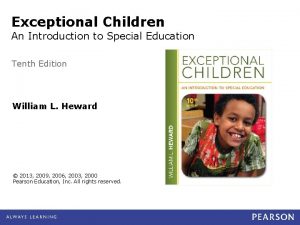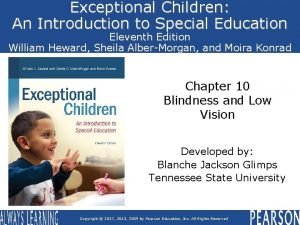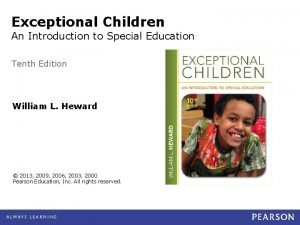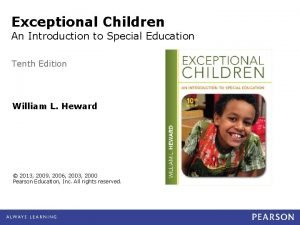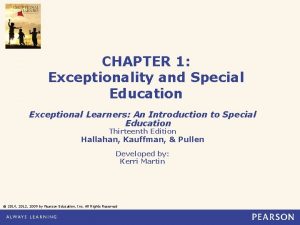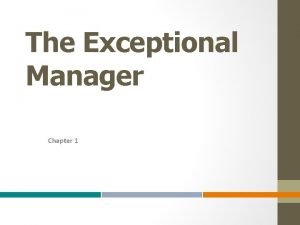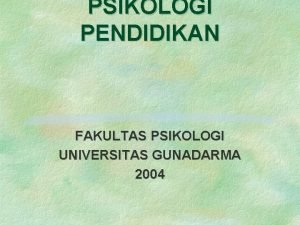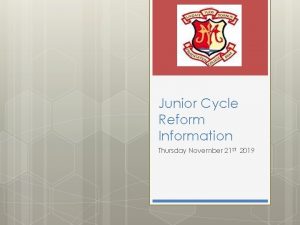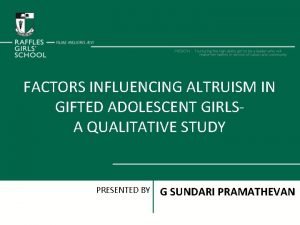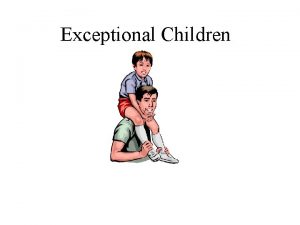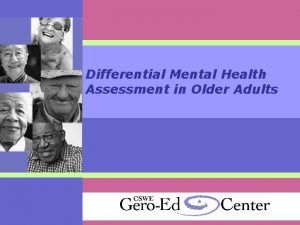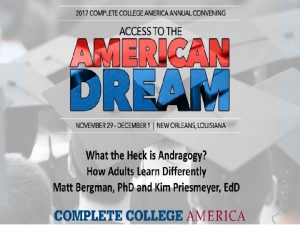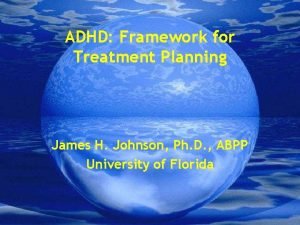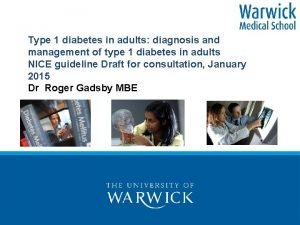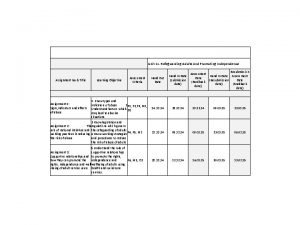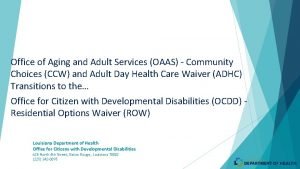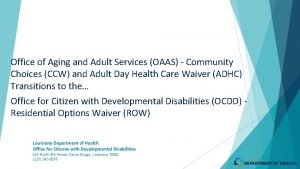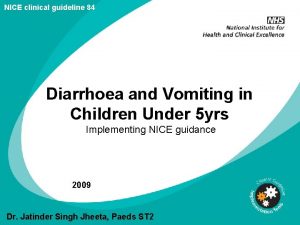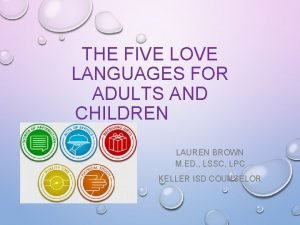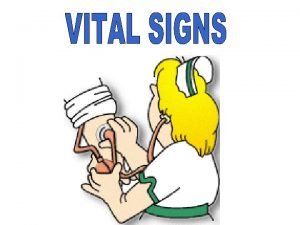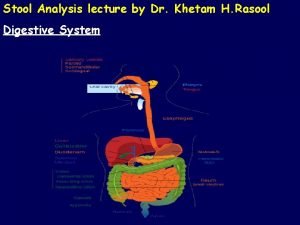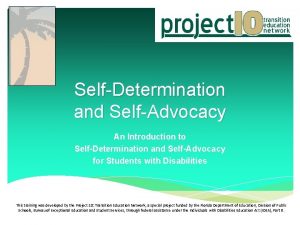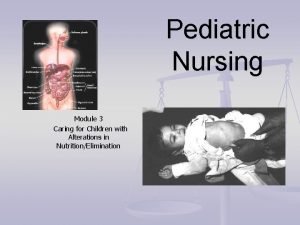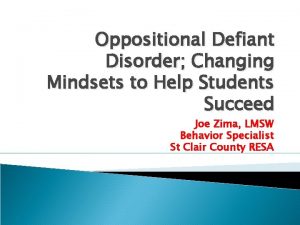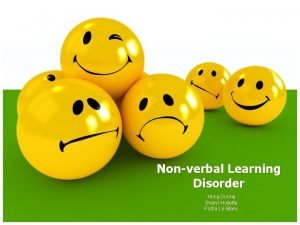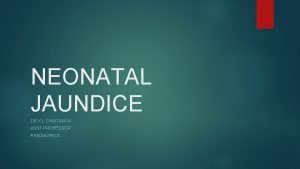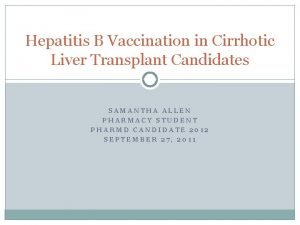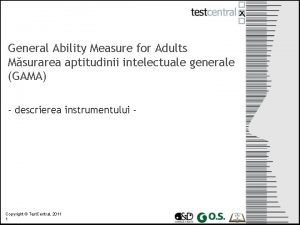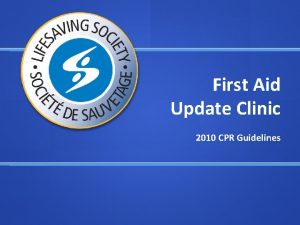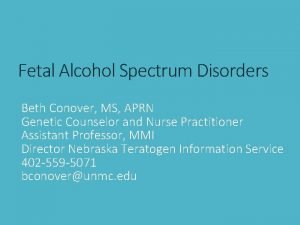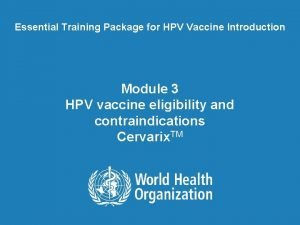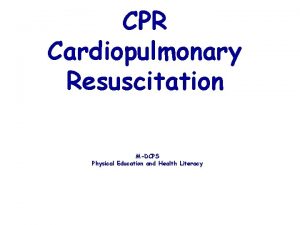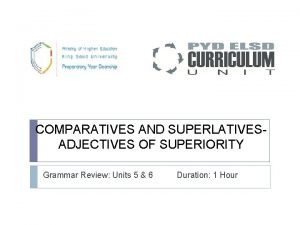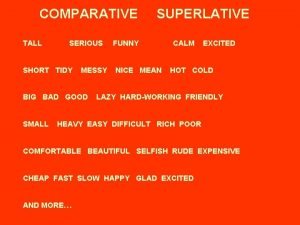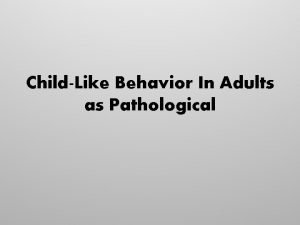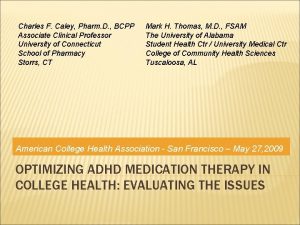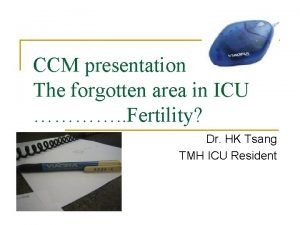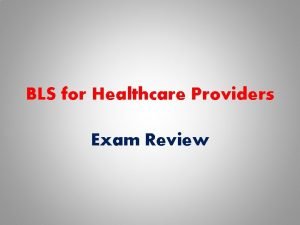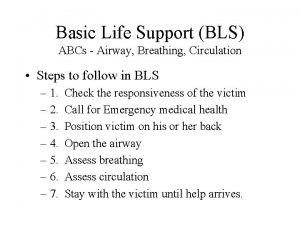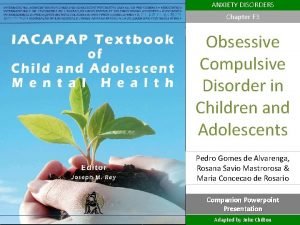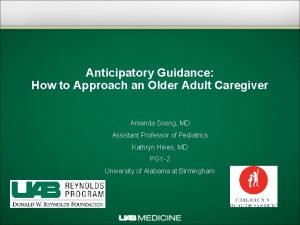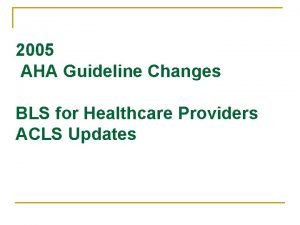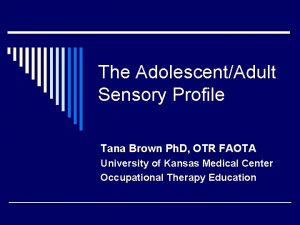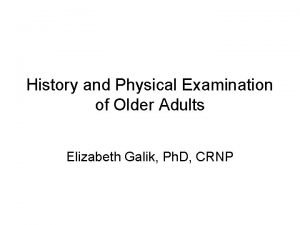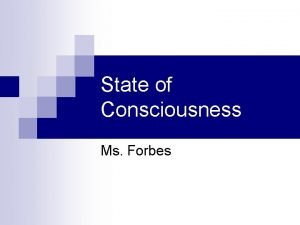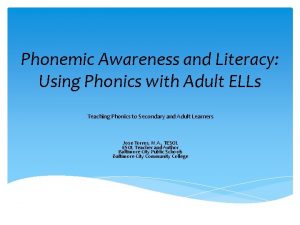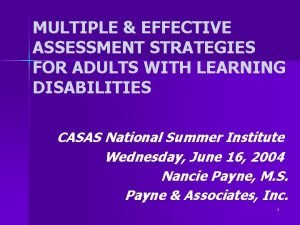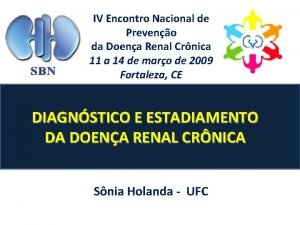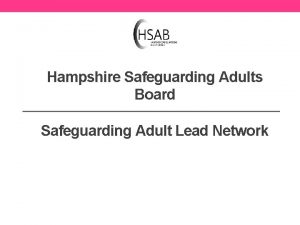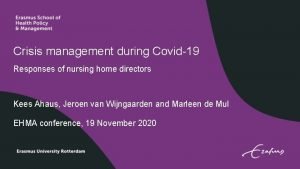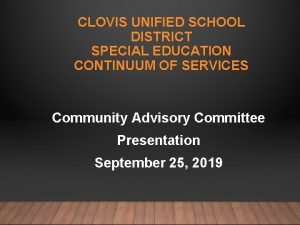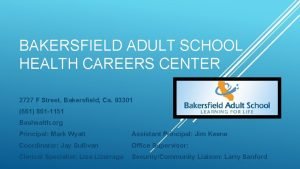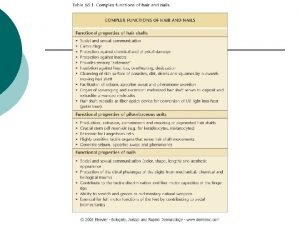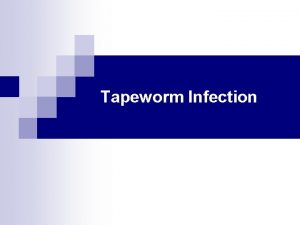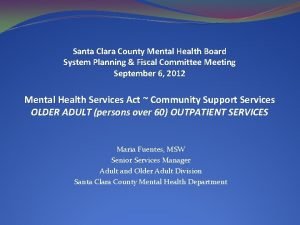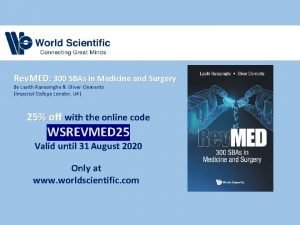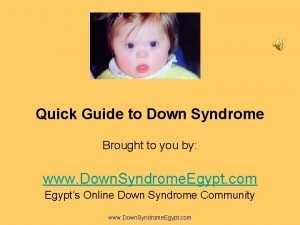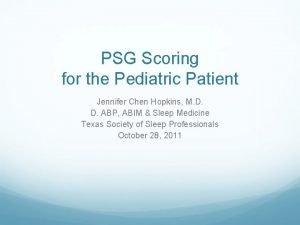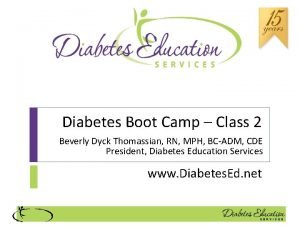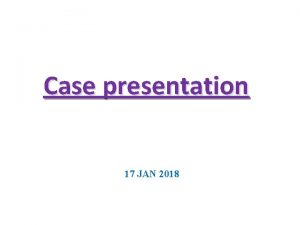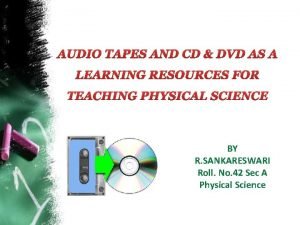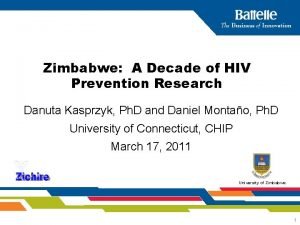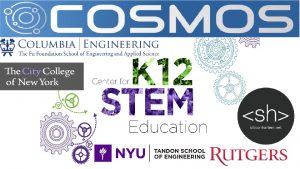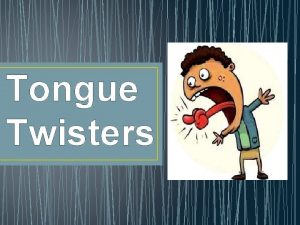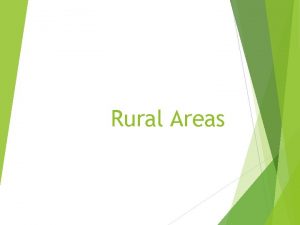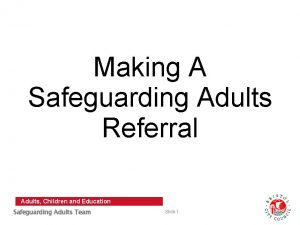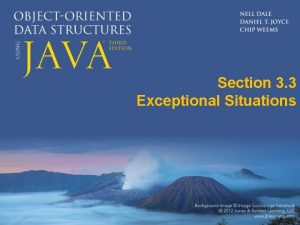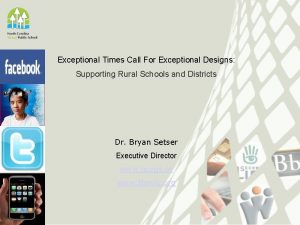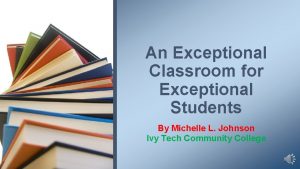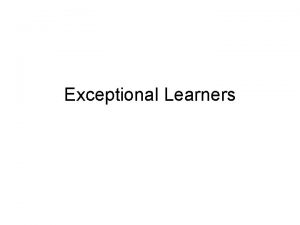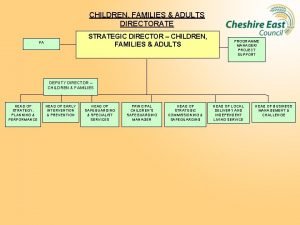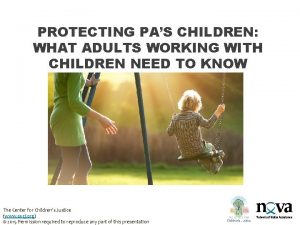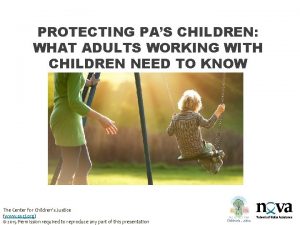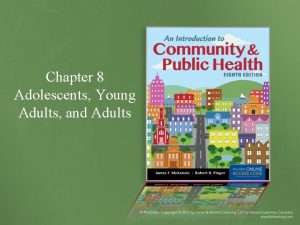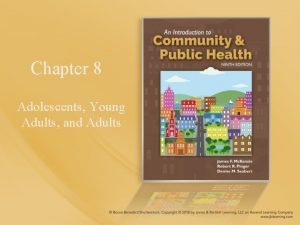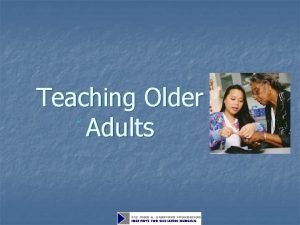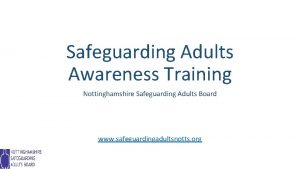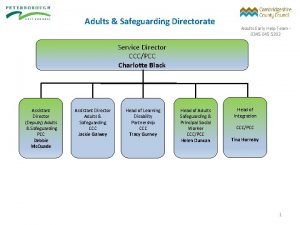Exceptional Children Areas of Exceptional Children and Adults






































































































- Slides: 102

Exceptional Children

Areas of Exceptional Children and Adults (Categorical Titles) • Multicultural and Bilingual Aspects of Special Education • Mental Retardation • Learning Disabilities • Emotional or Behavioral Disorders • Communication Disorders • Hearing Impairment • Visual Impairment • Physical Disabilities • Giftedness

Exceptional Children Definition Exceptional children and youths are those who require special education and related services if they are to realize their full human potential. They require special education because they are markedly different from most children in one or more of the following ways: They may have mental retardation, learning disabilities, emotional or behavioral disorders, physical disabilities, disorders of communication, autism, traumatic brain injury, impaired hearing, impaired sight, or special gifts or talents.

Exceptional Children Concepts Two concepts are important to our educational definition of exceptional children and youths: (1) diversity of characteristics and (2) need for special education. The concept of diversity is inherent in the definition of exceptionality; the need for special education is inherent in an educational definition.

Exceptional Children Prevalence refers to the percentage of a population or number of individuals having a particular exceptionality. The prevalence of mental retardation, for example, might be estimated at 2. 3 percent, which means that 2. 3 percent of the population, or twenty-three people in every thousand, are assumed to have mental retardation. If the prevalence of giftedness is assumed to be between 3 percent and 5 percent, we would expect somewhere between thirty and fifty people in a sample of a thousand to have special gifts of some kind. Obviously, accurate estimates of prevalence depend on our ability to count the number of people in a given population who have a certain exceptionality.

Exceptional Children Expectations Special educators have the responsibility to offer not just good instruction but instruction that is highly individualized, intensive, relentless, urgent, and goal directed.

Exceptional Children Myths/Facts

Exceptional Children Public schools may choose not to provide education for some students with disabilities. Federal legislation specifies that to receive federal funds, every school system must provide a free, appropriate education for every student regardless of any disabling condition.

Exceptional Children By law, the student with a disability must be placed in the least restrictive environment (LRE). The LRE is always the regular classroom. The law does require the student with a disability to be placed in the LRE. However, the LRE is not always the regular classroom. What the LRE does mean is that the student shall be separated as little as possible from home, family, community, and the regular class setting while appropriate education is provided. In many but not all instances, this will mean placement in the regular classroom.

Exceptional Children The causes of most disabilities are known, but little is known about how to help individuals overcome or compensate for their disabilities. In most cases, the causes of disabilities are not known, although progress is being made in pinpointing why many disabilities occur. More is known about the treatment of most disabilities than about their causes.

Exceptional Children People with disabilities are just like everyone else. First, no two people are exactly alike. People with disabilities, just like everyone else, are unique individuals. Most of their abilities are much like those of the average person who is not considered to have a disability. Nevertheless, a disability is a characteristic not shared by most people. It is important that disabilities be recognized for what they are, but individuals with disabilities must be seen as having many abilities -- other characteristics that they share with the majority of people.

Exceptional Children A disability is a handicap. A disability is an inability to do something, the lack of a specific capacity. A handicap, on the other hand , is a disadvantage that is imposed on an individual. A disability may or may not be a handicap, depending on the circumstances. For example, the inability to walk is not a handicap in learning to read, but it can me a handicap in getting into the stands at a ball game. Sometimes handicaps are needlessly imposed on people with disabilities. For example, a student who cannot write with a pen but can use a typewriter or word processor would be needlessly handicapped without such equipment.

Multicultural and Bilingual Aspects of Special Education Myths/Facts

Multicultural & Bilingual Aspects Multicultural education addresses the concerns of ethnic minorities who want their children to learn more about their history and the intellectual, social, and artistic contributions of their ancestors. This is a partial truth. In fact, multicultural education seeks to help the children of all ethnic groups appreciate their own and others’ cultural heritages-- plus our common American culture that sustains multiculturalism.

Multicultural & Bilingual Aspects Everyone agrees that multicultural education is critical to our nation’s future. Some people, including some who are members of ethnic minorities, believe that multicultural education is misguided and diverts attention from our integration in a distinctive, cohesive American culture.

Multicultural & Bilingual Aspects Implementing multicultural education is a relatively simple matter of including information about all cultures in the curriculum and teaching respect for them. Educators and others are struggling with how to construct a satisfactory multicultural curriculum and multicultural instructional methods. Nearly every aspect of the task is controversial-- which cultures to include, how much attention to give to each, and what and how to teach about them.

Multicultural & Bilingual Aspects Multiculturalism includes only the special features and contributions of clearly defined ethnic groups. Ethnicity is typically the focal point of discussions of multiculturalism, but ethnicity is sometimes a point of controversy if it is defined too broadly (for example, by lumping all Asians together). Besides ethnic groups, other groups and individuals-- such as people identified by gender, sexual orientation, religion, and disability -- need consideration in a multicultural curriculum.

Multicultural & Bilingual Aspects Disproportionate Representation of ethnic minorities in special education is no longer a problem. Some ethnic minorities are still underrepresented or overrepresented in certain special education categories. For example, African American students, especially males, are overrepresented in programs for students with emotional or behavioral disorders and underrepresented in programs for gifted and talented students.

Multicultural & Bilingual Aspects Disability is never related to ethnicity. Some disabilities are genetically linked and therefore more prevalent in some ethnic groups. For example, sickle cell disease (a severe, chronic, hereditary blood disease) occurs disproportionately in children with ancestry from Africa, Mediterranean and Caribbean regions, Saudi Arabia, and India.

Multicultural & Bilingual Aspects If students speak English, there is no need to be concerned about bilingual education. Conversational English is not the same as more formal and sometimes technical language used in academic curriculum and classroom instruction. Educators must make sure that students understand the language used in teaching, not just informal conversation.

Communication Disorders

Communication Disorders Categorical Factors Associated with Childhood Language Disorders I. Central factors A. Specific language disability B. Mental retardation C. Autism D. Attention deficit hyperactivity disorder E. Acquired brain injury F. Others II. Peripheral factors A. Hearing impairment B. Visual Impairment C. Physical Impairment

Communication Disorders Categorical Factors Associated with Childhood Language Disorders (cont. ) III. Environmental and emotional factors A. Neglect and abuse B. Behavioral and emotional development problems IV. Mixed factors

Causes Communication Disorders • Central factors refer to causes associated with central nervous system (i. e. , brain) damage or dysfunction. • Peripheral factors refer to sensory or physical impairments that are not caused by brain injury or dysfunction but that, nevertheless, contribute to language disorders. • Environmental and emotional factors refer to language disorders that have their primary origin in the child’s physical or psychological environment. • Mixed factors are included because language disorders often have multiple causes—combinations of central, peripheral, and environmental or emotional factors.

Communication Disorders Myths/Facts

Communications Disorders Children with language disorders always have speech difficulties as well. It is possible for a child to have good speech yet not make any sense when he or she talks; however, most children with language disorders have speech disorders, as well.

Communications Disorders Individuals with communication disorders always have emotional or behavioral disorders or mental retardation. Some children with communication disorders are normal in cognitive, social, and emotional development.

Communications Disorders How children learn language is now well understood. Although recent research has revealed quite a lot about the sequence of language acquisition and has led to theories of language development, exactly how children learn language is still unknown.

Communications Disorders Stuttering is primarily a disorder of people with extremely high IQs. Children who stutter become stuttering adults. Stuttering can affect individuals at all levels of intellectual ability. Some children who stutter continue stuttering as adults; most, however, stop stuttering before or during adolescence with help from a speech-language pathologist. Stuttering is primarily a childhood disorder, found much more often in boys than in girls.

Communications Disorders of phonology (or articulation) are never very serious and are always easy to correct. Disorders of phonology can make speech unintelligible; it is sometimes very difficult to correct phonological or articulation problems, especially if the individual has cerebral palsy, mental retardation, or emotional or behavioral disorders.

Communications Disorders There is no relationship between intelligence and communication disorders. Communications disorders tend to occur more frequently among individuals of lower intellectual ability, although they may occur in individuals who are extremely intelligent.

Communications Disorders There is not much overlap between language disorders and learning disabilities. Problems with verbal skills-- listening, reading, writing, speaking-- are often central features of learning disabilities. The definitions of language disorders and several other disabilities are overlapping.

Communications Disorders Children who learn few language skills before entering kindergarten can easily pick up all the skills they need, if they have good peer models in typical classrooms. Early language learning is critical for later language development; a child whose language is delayed in kindergarten is unlikely to learn to use language effectively merely by observing peer models. More explicit intervention is typically required.

Hearing Impairment

Hearing Impairment No deaf child who has earnestly tried to speak the words which he has never heard—to come out of the prison of silence, where no tone of love, no song of bird, no strain of music ever pierces the stillness—can forget the thrill of surprise, the joy of discovery which came over him when he uttered his first word. Only such a one can appreciate the eagerness with which I talked to my toys, to stones, trees, birds and dumb animals, or the delight I felt when at my call Mildred ran to me or my dogs obeyed my commands. It is an unspeakable boon to me to be able to speak in winged words that need no interpretation. --Helen Keller The Story of My Life

Hearing Impairment Definition and Classification The extreme points of view are represented by those with a physiological orientation versus those with an educational orientation. Those maintaining a strictly physiological viewpoint are interested primarily in the measurable degree of hearing loss. Children who cannot hear sounds at or above a certain intensity (loudness) level are classified as “deaf: ” others with a hearing loss are considered “hard of hearing”. Hearing sensitivity is measured in decibels (units of relative loudness of sounds). Zero decibels (0 d. B) designates the point at which the average person with normal hearing can detect the faintest sound. Each succeeding number of decibels indicates a certain degree of hearing loss. Those who maintain a physiological viewpoint generally consider people with hearing losses of about 90 d. B or greater to be deaf and people with less to be hard of hearing. People with an educational viewpoint are concerned with how much the hearing loss is likely to affect the child’s ability to speak and develop language. Because of the close causal link between hearing loss and delay in language development, these professionals categorize primarily on the basis of spoken language abilities. Following is the most commonly accepted set of definitions reflecting this educational orientation:

Hearing Impairment Definition and Classification (Cont. ) • Hearing impairment: is generic term indicating a hearing disability that may range in severity from mild to profound; it includes the subsets of deaf and hard of hearing. • A deaf person is one whose hearing disability precludes successful processing of linguistic information through audition, with or without a hearing aid. • A person who is hard of hearing generally, with the use of a hearing aid, has residual hearing sufficient to enable successful processing of linguistic information through audition Educators are extremely concerned about the age of onset of the hearing impairment. Again, the close relationship between hearing loss and language delay is the key here. The earlier the hearing loss occurs in a child’s life, the more difficulty he or she will have developing the language of the hearing society (e. g. , English). For this reason, professionals frequently use the terms congenitally deaf (those who were born deaf) and adventitiously deaf (those who acquire deafness at some time after birth). Two other frequently used terms are even more specific in pinpointing language acquisition as critical: Prelingual deafness is “deafness present at birth, or occurring early in life at an age prior to the development of speech or language”; postlingual deafness is “deafness occurring at any age following the development of speech and language”.

Hearing Impairment PREVALENCE The U. S. Department of Education’s statistics indicate that about 0. 14 percent of the population from six to seventeen years of age is identified as deaf or hard of hearing by the public schools. Although the U. S. Department of Education does not report separate figures for the categories of “deaf” and “hard of hearing, ” some authorities believe that many children who are hard of hearing who could benefit from special education are not being served. Congenitally deaf. Deafness that is present at birth; can be caused by genetic factors, by injuries during fetal development, or by injuries occurring at birth. Adventitiously deaf. Deafness that occurs through illness or accident in an individual who was born with normal hearing. Prelingual deafness. Deafness that occurs before the development of spoken language, usually at birth. Postlingual deafness. Deafness occurring after the development of speech and language.

Hearing Impairment Myth/Facts

Hearing Impairment Deafness is not as severe a disability as blindness Although it is impossible to predict the exact consequences of a disability on a person’s functioning , in general, deafness poses more difficulties in adjustment than does blindness. This is largely due to the effects hearing loss can have on the ability to understand speak oral language.

Hearing Impairment It is unhealthy for people who are deaf to socialize almost exclusively with others who are deaf. Many authorities now recognize that the phenomenon of a Deaf culture is natural and should be encouraged. In fact, some are worried that too much mainstreaming will diminish the influence of the Deaf culture.

Hearing Impairment In learning to understand what is being said to them, people with hearing impairment concentrate on reading lips. Lipreading refers only to visual cues arising from movement of the lips. Some people who are hearing impaired not only read lips but also take advantage of a number of other visual cues, such as facial expressions and movements of the jaw and tongue. They are engaging in what is referred to as speechreading.

Hearing Impairment Speechreading is relatively easy to learn and is used by the majority of people with hearing impairment. Speechreading is extremely difficult to learn, and very few people who are hearing impaired actually become proficient speechreaders.

Hearing Impairment American Sign Language (ASL) is a loosely structured group of gestures. ASL is a true language in its own right with its own set of grammatical rules.

Hearing Impairment ASL can convey only concrete ideas. ASL can convey any level of abstraction.

Hearing Impairment People within the Deaf community are in favor of mainstreaming students who are deaf into regular classes. Some within the Deaf community have voiced the opinion that regular classes are not appropriate for many students who are deaf. They point to the need for a critical mass of students who are deaf in order to have effective educational programs for these individuals. They see separate placements as a way of fostering the Deaf culture.

Hearing Impairment Families in which both the child and the parents are deaf are at a distinct disadvantage compared to families in which the parents are hearing. Research has demonstrated that children who are deaf who have parents who are also deaf fare better in a number of academic and social areas. Authorities point to the parents’ ability to communicate with their children in ASL as a major reason for this advantage.

Visual Impairment

Visual Impairment Legal Definition The legal definition of visual impairment involves assessment of visual acuity and field of vision. A person who is legally blind has visual acuity of 20/200 or less in the better eye even with correction (e. g. , eyeglasses) or has a field of vision so narrow that its widest diameter subtrends an angular distance no greater than 20 degrees. The fraction 20/200 means that the person sees at 20 feet what a person with normal vision sees at 200 feet. (Normal vision acuity is thus 20/20). Legal blindness qualifies a person for certain legal benefits, such as tax advantages and money for special materials. In addition to this medical classification of blindness, there is also a category referred to as partially sighted. According to the legal classification system, persons who are partially sighted have visual acuity falling between 20/70 and 20/200 in the better eye with correction.

Visual Impairment Educational Definition Many professionals, particularly educators, have found the legal classification scheme inadequate. They have observed that visual acuity is not a very accurate predictor of how people will function or use whatever remaining sight they have. Although a small percentage of individuals who are legally blind have absolutely no vision, the majority are able to see. For example, an extensive study of students who are legally blind found that only 18 percent were totally blind. Many of those who recognize the limitations of the legal definition of blindness and partial sightedness favor the educational definition, which stresses the method of reading instruction. For educational purposes, individuals who are blind are so severely impaired they must learn to read Braille or use aural methods (audiotapes and records). (Braille, a system of raised dots by which blind people read with their fingertips, consists of quadrangular cells containing from one to six dots whose arrangements denotes different letters and symbols. ) Educators often refer to those individuals with visual impairment who can read print, even if they need magnifying devices or large-print books, as having low vision.

Visual Impairment Prevalence Blindness is primarily an adult disability. Most estimates indicate that blindness is approximately one-tenth as prevalent in schoolage children as in adults. Only about. 05 percent of the population ranging from six to seventeen years of age is classified by the federal government as “visually impaired. ” This makes visual impairment one of the least prevalent disabilities in children.

Visual Impairment Myth/Facts

Visual Impairment People who are legally blind have no sight at all Only a small percentage of people who are legally blind have absolutely no vision. Many have a useful amount of functional vision.

Visual Impairment People who are blind have an extra sense that enables them to detect obstacles. People who are blind do not have an extra sense. Some can develop an “obstacle sense” by noting the change in pitch of echoes as they move toward objects.

Visual Impairment People who are blind automatically develop better acuity in their other senses. Through concentration and attention, individuals who are blind can learn to make very fine discriminations in the sensations they obtain. This is not automatic but rather represents a better use of received sensations.

Visual Impairment People who are blind have superior musical ability. The musical ability of people who are blind is not necessarily better than that of sighted people, however, many people who are blind pursue musical careers as one way in which they can achieve success.

Visual Impairment Braille is not very useful for the vast majority of people who are blind; it should only be tried as a last resort. Very few people who are blind have learned Braille, primarily due to fear that using it is a sign of failure and to an historical professional bias against it. Authorities acknowledge the utility of Braille for people who are blind.

Visual Impairment Braille is of no value for those who have low vision. Some individuals with low vision have conditions that will eventually result in blindness. More and more, authorities think that these individuals should learn Braille to be prepared for when they cannot read print effectively.

Visual Impairment If people with low vision use their eyes too much, their sight will deteriorate. Only rarely is this true. Visual efficiency can actually be improved through training and use. Wearing strong lenses, holding books close to the eyes, and using the eyes often cannot harm vision.

Visual Impairment Mobility instruction should be delayed until elementary school or secondary school Many authorities now recognize that even preschoolers can take advantage of mobility instruction, including the use of a cane.

Visual Impairment The long cane is a simply constructed, easyto-use device. The National Academy of Sciences has drawn up specifications for the manufacture of the long cane and using it properly.

Visual Impairment Guide dogs take people where they want to go. The guide dog does not “take” the person anywhere, the person must first know where he or she is going. The dog is primarily a protection against unsafe areas or obstacles.

Physical Disabilities

Physical Disabilities Definition and Classification Children with physical disabilities are defined as those whose physical limitations or health problems interfere with school attendance or learning to such an extent that special services, training, equipment, materials, or facilities are required. Our definition excludes children whose primary characteristics are visual or auditory impairments, although some children with physical disabilities have these deficiencies as secondary problems. Children who have physical disabilities may also have mental retardation, learning disabilities, emotional or behavioral disorders, communication disorders, or special gifts or talents.

Physical Disabilities Definition and Classification (cont. ) The fact that the primary distinguishing characteristics of children with physical disabilities are medical conditions, health problems, or physical limitations highlights the necessity of interdisciplinary cooperation.

Physical Disabilities Prevalence and Need Figures from the U. S. Department of Education (1994) indicate that over 200, 000 students are being served under three special education categories related to physical disabilities: 1. Orthopedic impairments (about 53, 000) 2. Other health impaired (about 66, 000) 3. Multiple disabilities (about 103, 000)

Physical Disabilities Traumatic Brain Injury (TBI) Definition The definition of TBI specifies that: 1. There is injury to the brain caused by an external force 2. The injury is not caused by a degenerative or congenital condition. 3. There is a diminished or altered state of consciousness. 4. Neurological or neurobehavioral dysfunction results from the injury

Physical Disabilities Traumatic Brain Injury (TBI) Variety of Causes TBI may involve open head injuries-- in which there is a penetrating head wound-- from such causes as a fall, gunshot, assault, vehicular accident, or surgery. TBI may involve closed head injuries, in which there is no open head wound, but brain damage is caused by internal compression, stretching, or other shearing motion of neural tissues within the head. Closed injuries may be caused by a variety of events including a fall, accident, or abuse, such as violent shaking.

Physical Disabilities Other Neurological Impairments Cerebral Palsy Is not a disease. It is not contagious, it is not progressive (except that improper treatment may lead to complications), and there are no remissions. Although it is often thought of as a motor problem associated with brain damage at birth, it is actually more complicated. For practical purposes, cerebral palsy can be considered part of a syndrome that includes motor dysfunction, psychological dysfunction, seizures, or emotional or behavioral disorders due to brain damage.

Physical Disabilities Other Neurological Impairments Cerebral Palsy (cont. ) Some individuals with CP show only one indication of brain damage, such as motor impairment; others may show combinations of symptoms. The usual definition of CP refers to a condition characterized by paralysis, weakness, lack of coordination, and/or other motor dysfunction because of damage to the child’s brain before it has matured. Symptoms may be so mild that they are detected only with difficulty or so profound that the individual is almost completely incapacitated. Although there is no cure for CP, advances in medical and rehabilitation technology offer increasing hope of overcoming the disabilities imposed by neurological damage.

Physical Disabilities Other Neurological Impairments Seizure Disorder (Epilepsy) A person has a seizure when there is an abnormal discharge of electrical energy in certain brain cells. The discharge spreads to nearby cells, and the effect may be loss of consciousness, involuntary movements, or abnormal sensory phenomena. The effects of the seizure will depend on the location of the cells in which the discharge starts and how far the discharge spreads. People with epilepsy have recurrent seizures. About 6 percent of the population will have a seizure at some time during life, but most of them will not be diagnosed as having epilepsy because they do not have repeated seizures. Seizures reflect abnormal brain activity, so it is not surprising that they occur more often in children with developmental disabilities than in children without disabilities.

Physical Disabilities Other Neurological Impairments Spina Bifida During early fetal development, the two halves of the embryo grow together or fuse at the midline. When the closure is incomplete, a congenital midline defect is the result. Cleft lip and cleft palate are examples of such midline defects. Spina Bifida is a congenital midline defect resulting from failure of the bony spinal column to close completely during fetal development. The defect may occur anywhere from the head to the lower end of the spine.

Physical Disabilities Other Neurological Impairments Spina Bifida (cont. ) Because the spinal column is not closed, the spinal cord (nerve fibers) may protrude, resulting in damage to the nerves and paralysis and/or lack of function or sensation below the site of the defect. Spina Bifida is often accompanied by paralysis of the legs and of the anal and bladder sphincters because nerve impulses are not able to travel past the defect. Surgery to close the spinal opening is performed in early infancy, but this does not repair the nerve damage. The mortality rate for children with spina bifida has lowered over the years, meaning that more severely impaired children are surviving and attending school. Although spina bifida is one of the most common birth defects resulting in physical disability, its causes are not known.

Physical Disabilities Musculoskeletal Conditions Muscular Dystrophy A hereditary disease characterized by progressive weakness caused by degeneration of muscle fibers.

Physical Disabilities Musculoskeletal Conditions Juvenile rheumatoid arthritis A systemic disease with major symptoms involving the muscles and joints.

Physical Disabilities Other Physical Conditions • Asthma • Cystic Fibrosis • Diabetes • Nephrosis and nephritis • Sickle-cell anemia • Hemophilia • Rheumatic fever • Tuberculosis • Cancer

Physical Disabilities Congenital Malformations Congenital malformations and disorders may occur in any organ system, and they may range from minor to fatal flaws ins structure or function. In many cases, the cause of the malformation or disorder is not known, but in others, it is known to be hereditary or caused by maternal infection or substance use by the mother during pregnancy.

Physical Disabilities Congenital Malformations (cont. ) Fetal Alcohol Syndrome (FAS): Abnormalities associated with the mother’s using alcohol during pregnancy, defects range from mild to severe, including growth retardation, brain damage, mental retardation, hyperactivity, anomalies of the face, and heart failure; also called alcohol embyopathy.

Physical Disabilities Congenital Malformations (cont. ) Acquired Immune Deficiency Syndrome (A. I. D. S. ) Acquired Immune Deficiency Syndrome (AIDS): A fatal virus-caused illness resulting in a breakdown of the immune system; currently, no known cure exists.

Physical Disabilities Myths/Facts

Physical Disabilities Cerebral palsy is a contagious disease. Cerebral palsy is not a disease. It is a nonprogressive neurological injury. It is a disorder of muscle control and coordination caused by injury to the brain before or during birth or in early childhood.

Physical Disabilities Physical disabilities of all kinds are decreasing because of medical advances. Because of advances in medical technology the number of children with severe disabilities is increasing. The number of survivors of serious medical conditions who develop normally or have mild impairments, such as hyperactivity and learning disabilities, is also increasing.

Physical Disabilities The greatest educational problem involving children with physical disabilities is highly specialized instruction. The greatest educational problem is teaching people without disabilities about what is is like to have a disability and how disabilities can be accommodated.

Physical Disabilities The more severe a person’s physical disability, the lower his or her intelligence. A person maybe severely physically disabled by cerebral palsy or another condition but have a brilliant mind.

Physical Disabilities People with epilepsy are mentally ill. People with epilepsy (seizure disorder) are not any more or less disposed to mental illness than those who do not have epilepsy.

Physical Disabilities Arthritis is found only in adults, particularly those who are elderly. Arthritic conditions are found in people of any age, including young children.

Physical Disabilities People with physical disabilities have no need for sexual expression. People with physical disabilities have sexual urges and need outlets for sexual expression.

Physical Disabilities The effects of traumatic brain injury are not distinguishable from those of other disabilities, such as mental retardation, learning disabilities, and emotional or behavioral disorders. A person who has had traumatic injury to the brain may, indeed, show cognitive, social, emotional, and behavioral characteristics much like those associated with other disabilities. However, the causes of these characteristics, their prognosis and course, and their management may be quite different from those of other disabilities.

Giftedness

Giftedness Federal Definitions Students who are gifted have special educational needs, but since giftedness is not a disability, in any usual sense, it is not defined in IDEA (the Individuals with Disabilities Education Act, passed in 1990), thus, no federal law requires special education for students who are gifted.

Giftedness Federal Definitions (cont. ) Federal Legislation does, however, encourage states to develop programs for gifted students and support research. Gifted and talented students are defined in federal law as children and youths who (1) give evidence of high performance capability in such areas as intellectual, creative, artistic, or leadership capacity or in specific academic fields and (2) require services or activities not ordinarily provided by the school in order to develop such capabilities fully.

Giftedness Prevalence It has been assumed in federal reports and legislation that 3 to 5 percent of the U. S. school population could be considered gifted or talented. Obviously the prevalence of giftedness is a function of the definition chosen. Giftedness is not something that sets people apart in every way from those who are average. Instead, it refers to specific, valued, and unusual talents that people may exhibit during some periods of their lives.

Giftedness Myths/Facts

Giftedness People who are gifted are physically weak, socially inept, narrow in interests, and prone to emotional instability and early decline. There are wide individual variations, and most gifted individuals are healthy, well adjusted socially attractive, and morally responsible.

Giftedness Gifted individuals are in a sense superhuman. Gifted people are not superhuman; rather, they are human beings with extraordinary gifts in particular areas. And like everyone else, they may have particular faults.

Giftedness Gifted children are usually bored with school and antagonistic toward those who are responsible for their education. Most gifted children like school and adjust well to their peers and teachers, although some do not like school and have social or emotional problems.

Gifted People who are gifted tend to be mentally unstable. Those who are gifted are about as likely to be well-adjusted and emotionally healthy as those who are not gifted.

Gifted We know that 3 to 5 percent of the population is gifted. The percentage of the population that is gifted depends on the definition of giftedness used. Some definitions include only 1 or 2 percent of the population; others, over 20 percent.

Giftedness is a stable trait, always consistently evident in all periods of a person’s life. Some of the remarkable talents and productivity of people who are gifted develop early and continue throughout life; in other cases, a person’s gifts or talents are noticed until adulthood. Occasionally, a child who shows outstanding ability becomes a nondescript adult.

Gifted People who are gifted do everything well. Some people characterized as gifted have superior abilities of many kinds; others have clearly superior talents in only one area.

Gifted A person is gifted if he or she scores above a certain level on intelligence tests. IQ is only one indication of one kind of giftedness. Creativity and high motivation are as important indications as general intelligence. Gifts or talents in some areas, such as the visual and performing arts, are not assessed by IQ tests.

Gifted Students who are truly gifted will excel without special education. They need only the incentives and instruction that are appropriate for all students. Some gifted children will perform at a remarkably high level without special education of any kind, and some will make outstanding contributions even in the face of great obstacles to their achievement. But most will not come close to achieving at a level commensurate with their potential unless their talents are deliberately fostered by instruction that is appropriate for their advanced abilities.
 Exceptional children 10th edition
Exceptional children 10th edition Introduction of exceptional child
Introduction of exceptional child Exceptional children 10th edition
Exceptional children 10th edition Exceptional children an introduction to special education
Exceptional children an introduction to special education Seoul national university events
Seoul national university events Raleigh & rosse measures to motivate exceptional service
Raleigh & rosse measures to motivate exceptional service Exceptional learners: an introduction to special education
Exceptional learners: an introduction to special education Exceptional manager
Exceptional manager Kategori exceptional people di indonesia
Kategori exceptional people di indonesia Cpars contractor response examples
Cpars contractor response examples Maths cba 1 ideas exceptional
Maths cba 1 ideas exceptional What is event in itil
What is event in itil Twice exceptional celebrities
Twice exceptional celebrities What is a cpwa
What is a cpwa Twice exceptional kids
Twice exceptional kids Conclusion of gifted child
Conclusion of gifted child Conclusion of exceptional child
Conclusion of exceptional child Mental health and older adults
Mental health and older adults Mental health and older adults
Mental health and older adults It is the art & science of helping adolescent learn
It is the art & science of helping adolescent learn Sample adhd treatment plan
Sample adhd treatment plan Type 1 diabetes in adults diagnosis and management
Type 1 diabetes in adults diagnosis and management Unit 11 safeguarding adults and promoting independence
Unit 11 safeguarding adults and promoting independence Office of aging and adults services
Office of aging and adults services Office of aging and adults services
Office of aging and adults services Nice guidelines diarrhoea and vomiting in adults
Nice guidelines diarrhoea and vomiting in adults What is selective mutism in adults
What is selective mutism in adults Pulse grading 2+
Pulse grading 2+ Vital signs normal range for pediatrics
Vital signs normal range for pediatrics Bluegrass billbugs overwinter as adults
Bluegrass billbugs overwinter as adults Love languages adults
Love languages adults Pulse sites
Pulse sites Examples of problem-solving scenarios
Examples of problem-solving scenarios Amoebiasis stool color for adults
Amoebiasis stool color for adults Self-determination worksheets pdf
Self-determination worksheets pdf Pyloromyotomy surgery
Pyloromyotomy surgery Odd diagnostic criteria
Odd diagnostic criteria Non verbal disability
Non verbal disability Jaundice grading in adults
Jaundice grading in adults Prison token economy
Prison token economy Template
Template Flask shaped
Flask shaped Hepatitis b vaccine schedule for adults
Hepatitis b vaccine schedule for adults Unhealthy relationships scenarios
Unhealthy relationships scenarios General ability measure for adults
General ability measure for adults Riddles vegetables
Riddles vegetables How many molars do adults have
How many molars do adults have Placement of aed pads on adults
Placement of aed pads on adults Adult with fetal alcohol syndrome
Adult with fetal alcohol syndrome Hpv vaccine schedule adults
Hpv vaccine schedule adults Oppositional defiant disorder in adults
Oppositional defiant disorder in adults Cpr ratio for adults
Cpr ratio for adults Superlatives for adults
Superlatives for adults Calm in comparative
Calm in comparative Childlike behavior in adults
Childlike behavior in adults Strattera vs adderall
Strattera vs adderall Altered cognition in older adults is commonly attributed to
Altered cognition in older adults is commonly attributed to Hyperammonemia causes in adults
Hyperammonemia causes in adults Lund browder chart adults
Lund browder chart adults The silence of adults bdo
The silence of adults bdo Chest compression for infant 2 rescuer
Chest compression for infant 2 rescuer Bls steps
Bls steps Ocd symptoms in adults
Ocd symptoms in adults Anticipatory guidance for elderly
Anticipatory guidance for elderly Vital signs chart normal range
Vital signs chart normal range Compression to ventilation ratio adults
Compression to ventilation ratio adults Is a child's urine the same as an adults
Is a child's urine the same as an adults Tana brown
Tana brown 1 inch
1 inch Conclusion of physical examination
Conclusion of physical examination Gaya belajar orang dewasa
Gaya belajar orang dewasa Dose calculation formula for adults
Dose calculation formula for adults Adults in scouting
Adults in scouting Wiltshire safeguarding
Wiltshire safeguarding Adults spend about ______% of their sleep in rem sleep.
Adults spend about ______% of their sleep in rem sleep. Schistosoma haematobium adults
Schistosoma haematobium adults How to teach phonics to adults
How to teach phonics to adults Assessment strategies for adults
Assessment strategies for adults Older adults
Older adults Safeguarding adults hampshire
Safeguarding adults hampshire Covids older adults
Covids older adults Clovis unified special education
Clovis unified special education A famous swashbuckling trio of old
A famous swashbuckling trio of old Bakersfield adult school
Bakersfield adult school Lanugo vs normal hair
Lanugo vs normal hair Tapeworm adults
Tapeworm adults Older adults mental health
Older adults mental health Hypersecretion of growth hormone in adults
Hypersecretion of growth hormone in adults Types of down syndrome
Types of down syndrome Hypnagogic hypersynchrony in adults
Hypnagogic hypersynchrony in adults Facilitation methods for adults
Facilitation methods for adults Beverly thomassian
Beverly thomassian Birmingham adult safeguarding
Birmingham adult safeguarding Heights of hot air balloons qualitative or quantitative
Heights of hot air balloons qualitative or quantitative Antihyperglycemic therapy in adults with type 2 diabetes
Antihyperglycemic therapy in adults with type 2 diabetes Examples of audio visual materials in teaching
Examples of audio visual materials in teaching Nsradio
Nsradio Worcestershire safeguarding board
Worcestershire safeguarding board Questions to ask to get to know someone
Questions to ask to get to know someone Normal bpm woman
Normal bpm woman Tongue twisters with x
Tongue twisters with x Maya's spending plan
Maya's spending plan Money smart fdic
Money smart fdic
